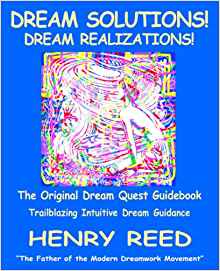
Paper I submitted for my Atlantic University TP5010 course – August 25, 2019
Following Henry Reed’s dream project, as outlined in his book, Dream Solutions! Dream Realizations, I began my 28-day dream quest on July 15th. I’ve always been interested in dreams, although I’ve never understood their full potential until now. When I began, my dream quest was simple and involved trying to learn where the Universe wants me to go next in terms of a 2nd career. As Reed promised, where I ended up was a complete surprise and one that will have repercussions for the rest of my life.
I have meditated for several years, and I’ve kept a dream journal for nearly two-years. Before my quest, I recalled a dream every 2-3 days at best. However, the number of dreams I remembered skyrocketed during the 4-week Dream Project. I didn’t miss a night without recording at least one dream, and there were times when I remembered 2 or 3. While meditation might have helped slightly, what had the most impact on my recall is what Reed points out in his chapter, “Applying Dream Insights: A Study of the Dream Quest Experience.” He uses the results of a scientific study to show that participants who put their dream insights into action “was an even more powerful stimulant [then meditation] to dream recall” (2005, p. 54). Interestingly, following the conclusion of the dream project, I’ve returned to only recalling a dream every 2-3 days, and the details aren’t nearly as vivid.
Robert Moss in the Secret History of Dreaming chronicles the importance that author Mark Twain placed on dreams. Twain describes the process of “drilling” dreams, which “involves writing dreams when they are fresh, then studying them and revisiting them…” (2009, p. 202). Many of his novels have their genesis in his dreams.
Reed’s Dream Project follows a similar approach
What this meant for my study nights is that I had at least ten dreams a week and sometimes more to sort through. I found that with this many dreams, I was able to see reoccurring patterns, identify those which had the most impact on my quest, and I could discard those I knew were the result of something that was going on in my life or was the product of a television show or movie I watched just before bed. The methodology I used for titling the dreams and ultimately selecting one for the week’s focus was to determine its relevance to an aspect of my quest. In some cases, they addressed only a portion, such as “get-away” place in a rural location. Other times they were broader, such a dream I had that involved not only a bar on the water, but also my employment there, which addressed multiple aspects of my quest.
With the intensity of the work required for the dream project, it was never far from my mind. This enabled me to learn things outside of my dream state that
It wasn’t only thoughts that helped me with my quest during waking hours. For example, I received two direct-mail marketing pieces that offered specific services that could help me with my life plan. The first was a seminar, and free steak, at Ruth Chris’s on the topic of a safe retirement investment. The other was a free 2-hour seminar given by an attorney with 30-years of estate planning experience. I attended both, and within a few weeks, I had a new retirement account from the first event, and I’ve retained an attorney to create a trust for me. He is also producing other critical documents such as a will, and a medical directive.
Carl Jung understood that events in life aren’t random, and he used the term “synchronicity” to describe what I experienced during my dream project when I connected my quest to events or thoughts during the waking day. Moss quotes researcher Suzanne Gieser, who called Jung’s synchronicity theory his “spiritual temperament.” She continues, “the principle of synchronicity is an attempt to pinpoint, alongside the law of causality, another factor ordering the world of our experience – a factor which builds on relatively simultaneously occurring constellations of a certain quality or significance” (2009, p. 225).
Another synchronicity I experienced during my dream project was several sightings of deer during my daily walk. I’ve seen them in the past, but not for nearly a year. Then they suddenly started appearing again when I began my quest. The Native Americans see deer as a messenger who represents sensitivity, intuition, and gentleness, according to the website Faena.com. I saw this as a sign that I was on the right track for a healing career, which was a large part of my dream questt.
Moss includes a chapter on Joan of Arc, and within it is a story about the Deer of Patay, a stag who saved the French army led by Jehanne from sure destruction. The British were laying a trap for Joan of Arc and her army, but a deer prevented them from completing the ambush. Moss quotes Jean de Wavrin, a captain who fought for the British that day, regarding what happened. The British soldiers were preparing their ambush in a field when “a stag came out of the woods, which plunged into the midst of the English battle line, whence arose a great cry, for they knew not that their enemy was so close to them” (2009, pp. 154-155). The deer I saw may not have changed history like the Deer of Patay, but they helped me alter the course of my life
References
Faena Aleph (2019), “Notes on the symbolism of deer,” Retrieved
Moss, R. (2009), The secret history of dreaming, New World Library: Novato, CA.
Reed, H. (2005), Dream Solutions! Dream Realization, Hermes Home Press: Mouth of Wilson, VA.